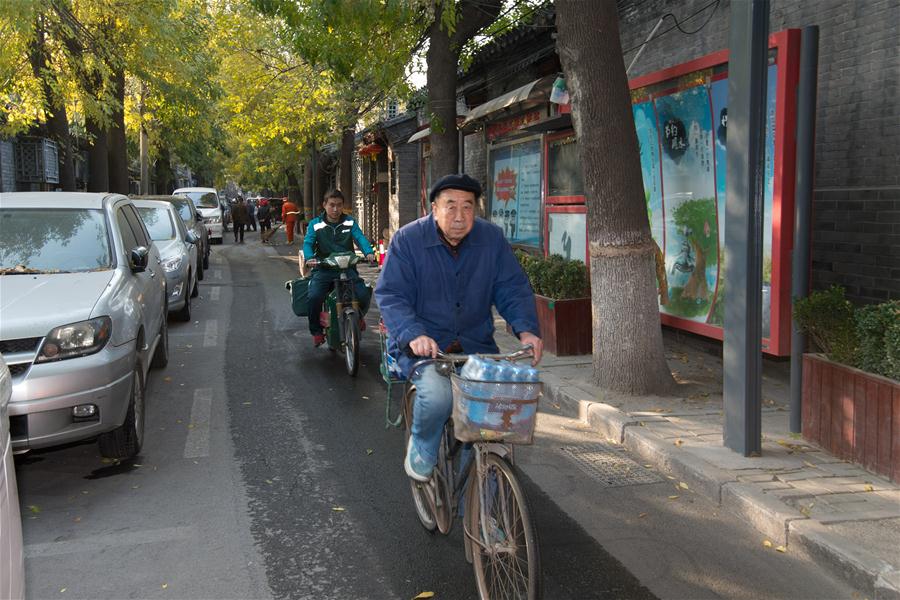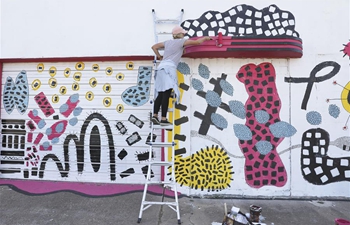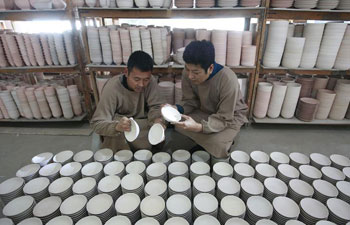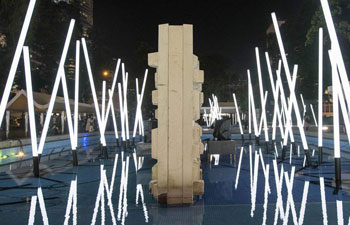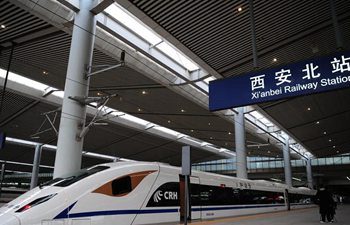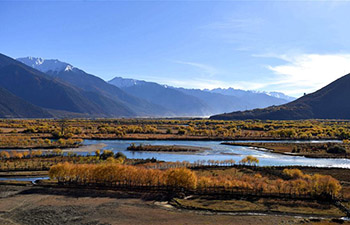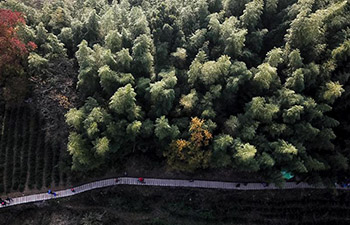A man rides his bicycle in Shijia Hutong of Beijing, capital of China, Nov. 1, 2017. In early winter in China's capital, you can still catch neighbors chatting to each other in their Beijing dialect along the city's hutong, or traditional alleys. This is a scene unchanged for centuries, but the topic of conversation now is often how to make their communities better places to live. (Xinhua/Wu Kaixiang)
BEIJING, Nov. 23 (Xinhua) -- In early winter in China's capital, you can still catch neighbors chatting to each other in their Beijing dialect along the city's hutong, or traditional alleys.
This is a scene unchanged for centuries, but the topic of conversation now is often how to make their communities better places to live.
Jin Dajun, 70, has lived in Dongsi Sitiao Hutong in the downtown Dongcheng District since he was a child. He has never left this place.
In recent years, the hutong have suffered substantially as low-end shops and restaurants moved in, making them chaotic and hazardous.
Jin and his neighbors are concerned. They want a clean, quiet neighborhood.
Deciding Call
In 2015, Dongsi sub-district, along with planning and other local government agencies, began to invite architects to design blueprints for the recovery of the old city, guided by experts at Tsinghua University's School of Architecture.
Jiang Zhaoshun, deputy director of the sub-district office, says they have implemented seven plans to restore and protect hutong and ancient buildings. "Resident representatives participated in making every plan," says Jiang.
"They have the deepest attachment to the areas where they've lived for decades. And it is they who can describe the original shape of the hutong."
However, transforming public spaces like hutong inevitably raises frictions. "In order to restore the hutong, we had to remove all unauthorized constructions. That triggered some resistance," says Jin.
Local government agencies and design companies had to consult the residents door-to-door and persuade them the environment would improve. "Some of the plans were discussed 30 times before they were nailed down," says Jin.
Two kilometers to the south, Chaoyangmen sub-district covers more than 30 hutong. In 2004, its office began to work with Beijing Municipal Institute of City Planning and Design and Beijing University of Technology.
They founded and developed Shijia Hutong Style Conservation Association to create a construction and governance model that combines top-down and bottom-up patterns, through a vast range of public participation.
Beijing Municipal Institute of City Planning and Design planner Zhao Xing says the conservation and updating of historic districts directly involved the residents, who had to be motivated to be partners and participants.
So far, the association has completed plans to transform the interior public spaces of seven courtyards. Residents have discussed and approved every stage.
Original Style
Since April, Dongsi sub-district has restored 74 gateways and refurbished 12,000 square meters of street walls, restoring exterior facades to their original gray color.
Dongsi Sitiao Hutong has seen the removal of 54 low-end businesses.
Dongsi sub-district has more than 20 hutong of various sizes. "The renovated hutong have the same appearance as they did in the Yuan Dynasty, and they basically retain the same length, width and architectural style," says sub-district committee secretary Xun Lianzhong. < After renovation, the hutong have resumed their place in community life and the "fly-ridden" restaurants have been removed along with their hustle and mess.
To the east of Dongsi, Xinzhong Street in Dongzhimen sub-district has 1,400 buildings awaiting demolition. They were once filled with sewage and garbage.
On rainy days, drains would block and the stinking water could be knee-high.
Illegal buildings made living conditions poor, says Xu Weiben, the official of Dongzhimen sub-district.
"Had there been any fire alarms, the fire trucks would have been unable to enter some narrow alleys," Xu says.
Last year, Dongzhimen sub-district began removing 259 illegal buildings covering 7,000 square meters and shutting unlicensed businesses.
These steps unblocked fire exits and reduced risks. The hutong is now decorated with flowers and has community squares. "Now it's much nicer to walk in the alley," says resident Yang Zhiguo, 77.
On September 29, Beijing unveiled a general city plan for 2016 to 2035, underlining the strengthening of historic and cultural building conservation, and strengthening urban characteristics in capital city style, ancient city flair and modern city landscaping.
The general city plan requires the preservation of more than 1,000 hutong and their names.
Plans are being made to provide more recreational, social and cultural public spaces. Hutong and alleys with traditional Beijing flair will be revived and hutong culture will be developed.
The plan also demands the preservation of traditional hutong architectural forms and the Siheyuan courtyard homes in the downtown area.
Palace Museum director Shan Jixiang argues the protection of hutong and Siheyuan will boost environmental and living standards, improve infrastructure and provide modern facilities for Siheyuan dwellers.
Strong tradition
Hutong are embedded in the genes of China's urban development, reflecting the richness and longevity of Chinese culture.
There are several theories about the origin of the word "hutong". Some say it is a transliteration of the word for "well" in Mongolian.
Most hutong in inner Beijing were originally built in the 13th Century, during the Yuan Dynasty and survived into the Ming and Qing dynasties.
In accordance with the standards of the time, most hutong were 700 meters long and intersected at 70-meter intervals.
According to Beijing Shijia Hutong Museum, this grid layout allowed easy partitioning and selling of land.
The old city encompasses 26.2 square kilometers, but little more than 1,000 hutong remain there. To reinforce their protection, the general city plan clearly states that hutong and their names should be preserved.
The city will also raise the proportion of historic and cultural districts from 22 percent to around 26 percent.
The government will strive to restore historic water-systems, rebuild city waterways, expand pedestrian spaces and develop interaction between private and public spaces.
It is hoped this will keep the existential continuity of these districts and revive historic aspects of the Ming and Qing dynasties as well as the Republic of China and People's Republic of China.
Deputy director of Chaoyangmen sub-district office Li Zhe believes the tenacious vitality of the hutong derives from the residents.
"As long as people still live there, it is alive," says Li. "If the process is only about architectural renovation and reconstruction, the hutong will lose their essence."




